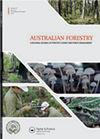Sandalwood trade and development in Papua New Guinea
IF 1.2
4区 农林科学
Q3 FORESTRY
引用次数: 3
Abstract
ABSTRACT The harvest and trade of sandalwood (Santalum macgregorii) from natural stands began in Papua New Guinea (PNG) in the late nineteenth century. Sporadic harvesting has occurred intermittently since then and continues to this day, with little active management to promote regeneration. This study was undertaken to determine the state of natural sandalwood resources in PNG, clarify the associated regulations for monitoring its trade and export, and identify practical options for local resource restoration through family and clan plantings. We studied export permit data, interviewed resource owners and traders, evaluated forestry legislation and regulation and engaged landowners in three areas of the country to establish sandalwood plantings. We found few regulations or monitoring protocols for sandalwood harvesting and trade in PNG. Export declarations are the only means for reporting the grades and volumes traded. There is evidence that both grades and prices have been underdeclared at point of export. No export permits in the last eight years contained records of any high-grade (A) products, and declared export values were lower than domestic prices paid to resource owners. Export records since 1997 reveal that significant volumes of up to 126 tonnes annually were traded in the early 2000s. The natural resource is yet to fully recover, with much lower volumes exported. To address the reduction in availability of natural sandalwood, we engaged landowners in three locations to establish sandalwood plantings. The results demonstrate that sandalwood, grown in agroforestry systems, can be productive in PNG, with mean basal stem diameter increments of up to 2.0 cm y−1 recorded. To further develop the sandalwood sector in PNG, we make four recommendations: (1) establish a ten-year moratorium on the sandalwood trade to enable the recovery of natural populations; (2) develop a product grading and sales registry system to improve trade transparency and monitoring; (3) reallocate the tax revenues generated from sandalwood exports to the PNG Forest Authority to fund the monitoring of harvesting and trade; and (4) promote options for resource restoration through family garden, boundary and enrichment plantings. The sandalwood industry in PNG has the potential to be viable and sustainable if the proposed recommendations are adopted by appropriate stakeholders to manage production and regulate the trade in the country and internationally.巴布亚新几内亚檀香贸易与发展
摘要:19世纪末,巴布亚新几内亚开始了对自然林分檀香(Santalum macgregorii)的采伐和贸易。从那时起,零星的收获就断断续续地发生,一直持续到今天,几乎没有积极的管理来促进再生。进行这项研究是为了确定巴布亚新几内亚天然檀香资源的状况,澄清监测其贸易和出口的相关法规,并确定通过家庭和宗族种植恢复当地资源的实际选择。我们研究了出口许可数据,采访了资源所有者和贸易商,评估了林业立法和法规,并与该国三个地区的土地所有者合作建立檀香种植。我们发现在巴布亚新几内亚几乎没有关于檀香采伐和贸易的法规或监测协议。出口申报是报告等级和贸易量的唯一方法。有证据表明,在出口时,等级和价格都少报了。在过去八年中,没有任何出口许可证包含任何高级(A)产品的记录,并且申报的出口价值低于支付给资源所有者的国内价格。自1997年以来的出口记录显示,本世纪初的年交易量高达126吨。自然资源尚未完全恢复,出口量要低得多。为了解决天然檀香供应减少的问题,我们与三个地点的土地所有者合作,建立了檀香种植园。结果表明,在农林复合系统中种植的檀香在巴布亚新几内亚具有生产力,平均基茎直径增量可达2.0 cm y - 1。为了进一步发展巴布亚新几内亚的檀香产业,我们提出了四项建议:(1)建立为期十年的檀香贸易禁令,以使自然种群得以恢复;(2)建立产品分级和销售登记制度,提高贸易透明度和监管;(3)将檀香出口产生的税收收入重新分配给巴布亚新几内亚林业局,以资助对采伐和贸易的监测;(4)推广通过家庭园林、边界种植和富集种植等方式进行资源修复的方案。如果拟议的建议被适当的利益攸关方采纳,以管理该国和国际上的生产和贸易,巴布亚新几内亚的檀香产业就有可能具有可行性和可持续性。
本文章由计算机程序翻译,如有差异,请以英文原文为准。
求助全文
约1分钟内获得全文
求助全文
来源期刊

Australian Forestry
FORESTRY-
CiteScore
3.70
自引率
4.80%
发文量
15
审稿时长
>12 weeks
期刊介绍:
Australian Forestry is published by Taylor & Francis for the Institute of Foresters of Australia (IFA) for scientific, technical, and professional communication relating to forestry in the Asia Pacific.
 求助内容:
求助内容: 应助结果提醒方式:
应助结果提醒方式:


